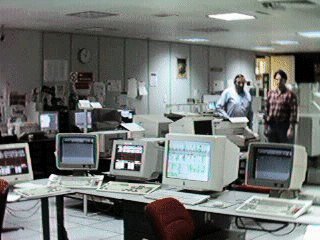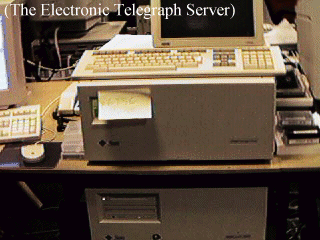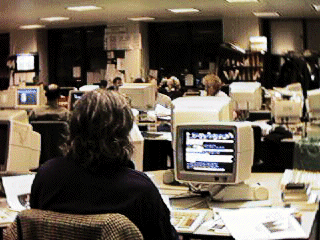Late Night News: The Electronic Telegraph
 7pm. I take the Docklands Light Railway to Canary Wharf. High up in the tower is The Telegraph Group. The Electronic Telegraph [1] (known as ET, and not the ET I’m told) sits one floor above The Daily Telegraph, which occupies several floors. A small man in a very large foyer hands me a security tag, and a member of staff comes down to collect me, since a swipe card is needed for all internal doors. We go up in the lift, and I set my eyes on the ET offices. They are open plan, they are full of computers, and the air is filled with the sound of the clicks of mouse buttons. The editors have been here since 4pm and are busy at their screens.
7pm. I take the Docklands Light Railway to Canary Wharf. High up in the tower is The Telegraph Group. The Electronic Telegraph [1] (known as ET, and not the ET I’m told) sits one floor above The Daily Telegraph, which occupies several floors. A small man in a very large foyer hands me a security tag, and a member of staff comes down to collect me, since a swipe card is needed for all internal doors. We go up in the lift, and I set my eyes on the ET offices. They are open plan, they are full of computers, and the air is filled with the sound of the clicks of mouse buttons. The editors have been here since 4pm and are busy at their screens.
 Electronic Telegraph is very different from The Daily Telegraph, despite the fact that they share the same news sources. ET has its own team, and the editor Derek Bishton, has a free hand in what he chooses to include. The content, running order and front page of ET may resemble those of The Daily Telegraph, but will not be identical. Sometimes there will be significant differences. During a recent hijacking event, the ET Deputy Editor was able to wait through the night for the plane to land safely at Stansted Airport. The news could be published on the server in minutes, making this the only morning paper to cover that story, as the others had already gone to press.
Electronic Telegraph is very different from The Daily Telegraph, despite the fact that they share the same news sources. ET has its own team, and the editor Derek Bishton, has a free hand in what he chooses to include. The content, running order and front page of ET may resemble those of The Daily Telegraph, but will not be identical. Sometimes there will be significant differences. During a recent hijacking event, the ET Deputy Editor was able to wait through the night for the plane to land safely at Stansted Airport. The news could be published on the server in minutes, making this the only morning paper to cover that story, as the others had already gone to press.
ET gets a different readership from The Daily Telegraph and this affects editorial policy. The ET audience is more international, it’s younger, and it’s male-dominated. ET is more likely to cover stories about the Internet, IT, education, international affairs and environmental issues. It is less likely to cover UK specific stories, or fashion items. It does not have a leader column or a letters page.
 8pm. I’m watching the Deputy Editor in action. He has two computers on his desk. One brings in the news, the other is a Mac which has Netscape, email, and some editing tools open. The editor is scanning and altering the text of incoming stories. Once the content is sorted, he transfers the file onto the Mac, and begins marking up with HTML. Macros are used to save time and effort in the mark-up process so time spent on this is minimal.
8pm. I’m watching the Deputy Editor in action. He has two computers on his desk. One brings in the news, the other is a Mac which has Netscape, email, and some editing tools open. The editor is scanning and altering the text of incoming stories. Once the content is sorted, he transfers the file onto the Mac, and begins marking up with HTML. Macros are used to save time and effort in the mark-up process so time spent on this is minimal.
 Hypertext, archives and hot-links add significant value to the news stories. For each story the editors do two types of search. Firstly, they do a local search of the ET archive, which contains full text of every edition since November 1994. Hyperlinks to articles in the archive help give each story a context and a history. Secondly, a global Internet search is done to produce a list of hot-links to external sites which support the story in some way. When I was there one story was captioned: “Leaked memo questions safety of burying atomic waste at Sellafield” The hot-links took readers to: a full text version of the leaked memo; details of the Friends of the Earth Planning Inquiry; and the home pages of British Nuclear Fuels, Greenpeace and Nirex. The editor commented that ET prides itself on being good at analysis, and on providing background information. He is willing to point to any site that is ‘legal, interesting and relevant.’ These links can give a natural balance to a story - in ET it seems there are links to as many left- wing sites as right-wing.
Hypertext, archives and hot-links add significant value to the news stories. For each story the editors do two types of search. Firstly, they do a local search of the ET archive, which contains full text of every edition since November 1994. Hyperlinks to articles in the archive help give each story a context and a history. Secondly, a global Internet search is done to produce a list of hot-links to external sites which support the story in some way. When I was there one story was captioned: “Leaked memo questions safety of burying atomic waste at Sellafield” The hot-links took readers to: a full text version of the leaked memo; details of the Friends of the Earth Planning Inquiry; and the home pages of British Nuclear Fuels, Greenpeace and Nirex. The editor commented that ET prides itself on being good at analysis, and on providing background information. He is willing to point to any site that is ‘legal, interesting and relevant.’ These links can give a natural balance to a story - in ET it seems there are links to as many left- wing sites as right-wing.
10.15pm. It’s time to go downstairs to get the proofs of tomorrow’s Daily Telegraph. ET editors want to compare front pages, and to find suitable pictures. It’s entertaining to see The Daily Telegraph offices. At the Sports desk they’re watching footy on TV. The City Desk has grey-haired gentlemen bent over their screens. Glossy magazines and vases of flowers adorn the Fashion Section, while in Obituaries the table is stacked with large, black tomes. A sea of news desks stretches out to the horizon, and in the corner Matt, the cartoonist, has a three foot model dog with bloodshot eyes gently patting his computer.
 11.10pm. Back at ET it’s time to decide on the running order. Things are pretty flexible as space is not a consideration. ET often carries much more information than The Daily. This makes me think about the other ways that electronic publications can be manipulated. The archives are potentially a very valuable research tool for academics, but does the ET ever make any retrospective changes to its copy? To date changes have been few, but if legal action was brought against the paper, libel would be removed. If external links prove to be less useful than originally thought, they may be removed.
11.10pm. Back at ET it’s time to decide on the running order. Things are pretty flexible as space is not a consideration. ET often carries much more information than The Daily. This makes me think about the other ways that electronic publications can be manipulated. The archives are potentially a very valuable research tool for academics, but does the ET ever make any retrospective changes to its copy? To date changes have been few, but if legal action was brought against the paper, libel would be removed. If external links prove to be less useful than originally thought, they may be removed.
12.50am. The editing is finished and the files are being copied onto the server. Sighs of relief all round and a chance to ask about future plans. ET is not yet paying for itself, but with advertising and sponsorship it soon will be. Meanwhile it seems to be boosting sales of the paper version, as a new generation and group of readers are being brought in. One of the editors assures me “You’ll never have to pay for ET”, but it is possible that micro-payments for hits in the archive will be introduced in the long term. It’s commercially sensitive for ET to talk about its future innovations, but I can say that they are looking at new JAVA applications; at allowing users to customise the paper to match individual interests; at the development of subject based online resources, and at including more sections from the paper copy.
At 1.15am the new edition of ET goes live. One of Europe’s most accessed WWW sites, hits the virtual newstands.
References
- Electronic Telegraph Web Site,
http://www.telegraph.co.uk/
Author Details
Emma WorsfoldResearch Officer on the SOSIG and DESIRE projects
Email: emma.worsfold@bris.ac.uk
Web page: http://www.ilrt.bris.ac.uk/about/staff/emma.html
Tel: 0117 9288 443
Address: Institute for Learning and Research Technology, University of Bristol, Bristol
